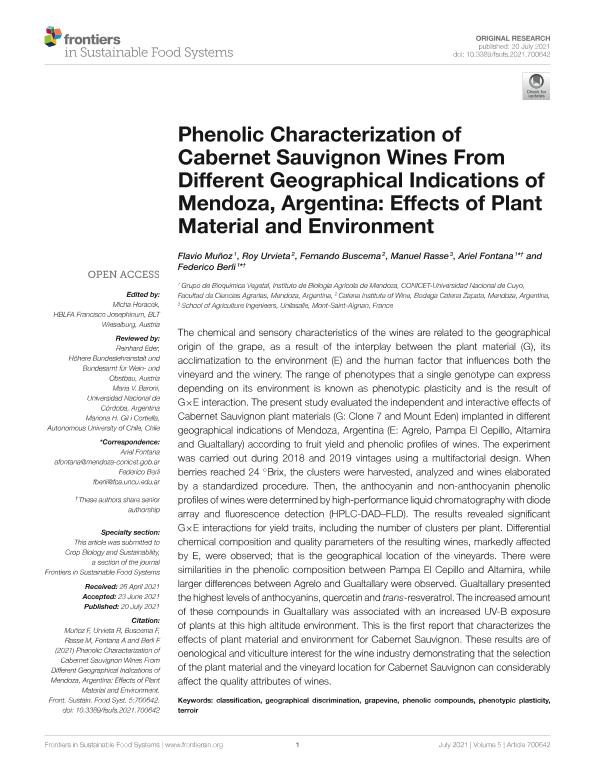Mostrar el registro sencillo del ítem
dc.contributor.author
Muñoz, Flavio Andres

dc.contributor.author
Urvieta, Roy Alexander

dc.contributor.author
Buscema, Fernando

dc.contributor.author
Rasse, Manuel
dc.contributor.author
Fontana, Ariel Ramón

dc.contributor.author
Berli, Federico Javier

dc.date.available
2021-12-10T12:13:03Z
dc.date.issued
2021-07
dc.identifier.citation
Muñoz, Flavio Andres; Urvieta, Roy Alexander; Buscema, Fernando; Rasse, Manuel; Fontana, Ariel Ramón; et al.; Phenolic Characterization of Cabernet Sauvignon Wines From Different Geographical Indications of Mendoza, Argentina: Effects of Plant Material and Environment; Frontiers Media; Frontiers in Sustainable Food Systems; 5; 7-2021; 1-14
dc.identifier.issn
2571-581X
dc.identifier.uri
http://hdl.handle.net/11336/148531
dc.description.abstract
The chemical and sensory characteristics of the wines are related to the geographical origin of the grape, as a result of the interplay between the plant material (G), its acclimatization to the environment (E) and the human factor that influences both the vineyard and the winery. The range of phenotypes that a single genotype can express depending on its environment is known as phenotypic plasticity and is the result of G × E interaction. The present study evaluated the independent and interactive effects of Cabernet Sauvignon plant materials (G: Clone 7 and Mount Eden) implanted in different geographical indications of Mendoza, Argentina (E: Agrelo, Pampa El Cepillo, Altamira and Gualtallary) according to fruit yield and phenolic profiles of wines. The experiment was carried out during 2018 and 2019 vintages using a multifactorial design. When berries reached 24 °Brix, the clusters were harvested, analyzed and wines elaborated by a standardized procedure. Then, the anthocyanin and non-anthocyanin phenolic profiles of wines were determined by high-performance liquid chromatography with diode array and fluorescence detection (HPLC-DAD–FLD). The results revealed significant G × E interactions for yield traits, including the number of clusters per plant. Differential chemical composition and quality parameters of the resulting wines, markedly affected by E, were observed; that is the geographical location of the vineyards. There were similarities in the phenolic composition between Pampa El Cepillo and Altamira, while larger differences between Agrelo and Gualtallary were observed. Gualtallary presented the highest levels of anthocyanins, quercetin and trans-resveratrol. The increased amount of these compounds in Gualtallary was associated with an increased UV-B exposure of plants at this high altitude environment. This is the first report that characterizes the effects of plant material and environment for Cabernet Sauvignon. These results are of oenological and viticulture interest for the wine industry demonstrating that the selection of the plant material and the vineyard location for Cabernet Sauvignon can considerably affect the quality attributes of wines.
dc.format
application/pdf
dc.language.iso
eng
dc.publisher
Frontiers Media

dc.rights
info:eu-repo/semantics/openAccess
dc.rights.uri
https://creativecommons.org/licenses/by/2.5/ar/
dc.subject
CLASSIFICATION
dc.subject
GEOGRAPHICAL DISCRIMINATION
dc.subject
GRAPEVINE
dc.subject
PHENOLIC COMPOUNDS
dc.subject
PHENOTYPIC PLASTICITY
dc.subject
TERROIR
dc.subject.classification
Otras Ciencias Biológicas

dc.subject.classification
Ciencias Biológicas

dc.subject.classification
CIENCIAS NATURALES Y EXACTAS

dc.title
Phenolic Characterization of Cabernet Sauvignon Wines From Different Geographical Indications of Mendoza, Argentina: Effects of Plant Material and Environment
dc.type
info:eu-repo/semantics/article
dc.type
info:ar-repo/semantics/artículo
dc.type
info:eu-repo/semantics/publishedVersion
dc.date.updated
2021-12-03T20:12:34Z
dc.journal.volume
5
dc.journal.pagination
1-14
dc.journal.pais
Suiza

dc.description.fil
Fil: Muñoz, Flavio Andres. Consejo Nacional de Investigaciones Científicas y Técnicas. Centro Científico Tecnológico Conicet - Mendoza. Instituto de Biología Agrícola de Mendoza. Universidad Nacional de Cuyo. Facultad de Ciencias Agrarias. Instituto de Biología Agrícola de Mendoza; Argentina
dc.description.fil
Fil: Urvieta, Roy Alexander. Catena Institute Of Wine.; Argentina. Consejo Nacional de Investigaciones Científicas y Técnicas. Centro Científico Tecnológico Conicet - Mendoza. Instituto de Biología Agrícola de Mendoza. Universidad Nacional de Cuyo. Facultad de Ciencias Agrarias. Instituto de Biología Agrícola de Mendoza; Argentina
dc.description.fil
Fil: Buscema, Fernando. Catena Institute Of Wine.; Argentina
dc.description.fil
Fil: Rasse, Manuel. School of Agriculture Ingenieers; Francia
dc.description.fil
Fil: Fontana, Ariel Ramón. Consejo Nacional de Investigaciones Científicas y Técnicas. Centro Científico Tecnológico Conicet - Mendoza. Instituto de Biología Agrícola de Mendoza. Universidad Nacional de Cuyo. Facultad de Ciencias Agrarias. Instituto de Biología Agrícola de Mendoza; Argentina
dc.description.fil
Fil: Berli, Federico Javier. Consejo Nacional de Investigaciones Científicas y Técnicas. Centro Científico Tecnológico Conicet - Mendoza. Instituto de Biología Agrícola de Mendoza. Universidad Nacional de Cuyo. Facultad de Ciencias Agrarias. Instituto de Biología Agrícola de Mendoza; Argentina
dc.journal.title
Frontiers in Sustainable Food Systems
dc.relation.alternativeid
info:eu-repo/semantics/altIdentifier/url/https://www.frontiersin.org/articles/10.3389/fsufs.2021.700642/full#impact
dc.relation.alternativeid
info:eu-repo/semantics/altIdentifier/doi/http://dx.doi.org/10.3389/fsufs.2021.700642
Archivos asociados
